Flat Out at Frankfurt
Page 46
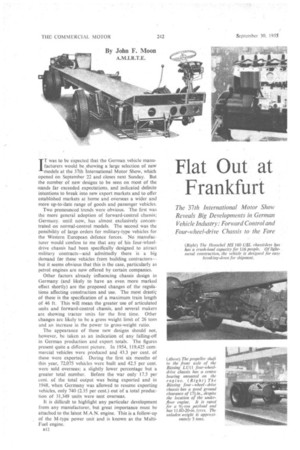
Page 47
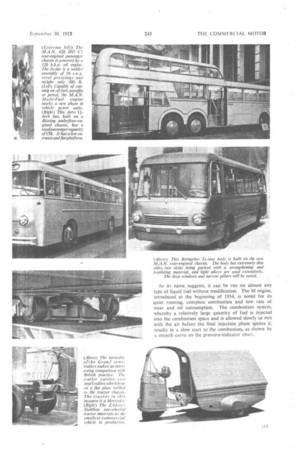
Page 48
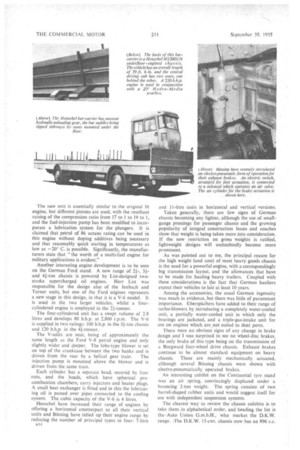
Page 49
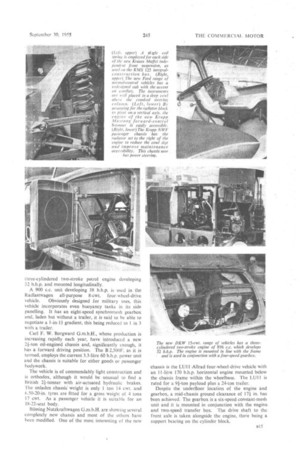
Page 50
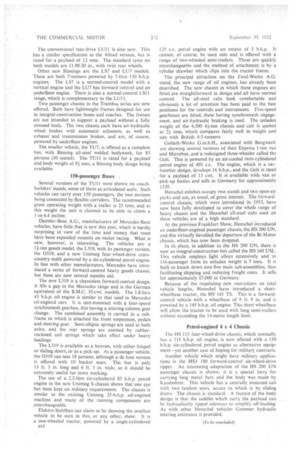
If you've noticed an error in this article please click here to report it so we can fix it.
IT was to be expected that the German vehicle manufacturers would be showing a large selection of new Models:at the 37th International Motor Show, which opened On September. 22 and closes next Sunday. But the number -of new .designs to be seen on most of the stands far exceeded expectations, and indicated definite intentions to break into new export markets and to offer established markets at home and overseas a wider and more up-to-date range of goods and passenger vehicles.
Two pronounced 'trends were obvious. The first was the more general adoption of forward-control chassis; Germany. until now, has almost exclusively concentrated on normal-control models. The second was the possibility of large orders for military-type vehicles for the Western European defence forces. No manufacturer would confess to me that any of his four-wheeldrive chassis had been specifically designed to attract military contracts—and admittedly there is a big demand for these vehicles from building contractors— but it seems obvious that this is the case, particularly as petrol engines are now offered by certain companies.
Other factors already influencing chassis design in Germany (and likely to have an even more marked effect shortly) are the proposed changes of the regulations affecting construction and use. The most drastic of these is the specification of a maximum train length of 46 ft. This will mean the greater use of articulated units and forward-control chassis, and several makers are showing tractor units for the first time. Other changes are likely to be a gross weight limit of 26 tons and an increase in the power to gross-weight ratio.
The appearance of these new designs should not, however, be taken as an indication of any falling-off in German production and export totals. The figures present quite a different picture. In 1954, 119,425 commercial vehicles were produced and 43.3 per cent. of these were exported. During the first six months of this year, 72,075 vehicles were built and 42.5 per cent. were sold overseas; a slightly lower percentage but a greater total number. Before the war only 17.5 per cent. of the total output was being exported and in 1948, when Germany was allowed to resume exporting vehicles, only 740 (2.35 per cent.) out Of a total production of 31,349 units were sent overseas.
It is difficult to highlight any particular development from any manufacturer, but great importance must be attached to the latest M.A.N. engine. This is a follow-up of the M-type power unit and is known as the Multi. Fuel engine.
As its name, suggests, it can be run on almost any type of liquid fuel without modification. The M engine, introduced at the beginning of 1954, is noted for its "quiet running, complete combustion and low rate of wear and oil consumption. The combustion system, whereby a relatively large quantity of fuel is injected into the combustion space and is allowed slowly to mix with the air before the final injection phase ignites it, results in a slow start to the combustion, as shown by a smooth curve on the pressure-indicator chart.
The new unit is essentially similar to the original M engine, but different pistons are used, with the resultant raising of the compression ratio from 17 to 1 to 19 to 1, and the fuel-injection pump has been modified to incorporate a lubrication system for the plungers. It is claimed that petrol of 86 octane rating can be used in this engine without doping additives being necessary and that reasonably quick starting in temperatures as low as —20° C. is possible. Significantly, the manufacturers state that " the worth of a multi-fuel engine for military applications is evident?'
Another interesting engine development is to be seen on the German Ford stand. A new range of 2i-, nand 41--ton chassis is powered by List-designed twostroke supercharged oil engines. Herr List was responsible for the design also of the Jenbach and Turner units, but one of the Ford engines represents a new stage in this design, in that it is a V-6 model. It is used in the two larger vehicles, whilst a fourcylindered engine is employed in the 2.1-tonner.
The four-cylindered unit has a swept volume of 2.8 litres and develops 80 b.h.p. at 2,800 r.p.m. The V-6 is supplied in two ratings: 100 b.h.p. in the 3i-ton chassis and 120 b.h.p. in the 41--tonner.
The V-units are neat, being of approximately the same length as the Ford V-8 petrol engine and only slightly wider and deeper. The lobe-type blower is set on top of the crankcase between the two banks and is driven from the rear by a helical gear train. The injection pump is mounted above the blower and is driven from the same train.
Each cylinder has a separate head, secured by four nuts, and the heads, which have spherical precombustion chambers, carry injectors and heater plugs. A small heat exchanger is fitted and in this the lubricating oil is passed over pipes connected to the cooling system. The cubic capacity of the V-6 is 4 litres.
Henschel have increased their range of engines by offering a horizontal counterpart to all their vertical units and Bussing have tidied up their engine range by reducing the number of principal types to four: 7-litre al4 and 11-litre units in horizontal and vertical versions.
Taken generally, there are few signs of German chassis becoming any lighter, although the use of smallgauge pressings for passenger chassis and the growing popularity of integral construction buses and coaches show that weight is being taken more into consideration. If the new restriction on gross weights is ratified, lightweight designs will undoubtedly become more prominent.
As was pointed out to me, the principal reason for the high weight (and cost) of most heavy goods chassis is the need for a powerful engine, with a correspondingly big transmission layout, and the allowances that have to be made for hauling heavy trailers. Coupled with these considerations is the fact that German hauliers expect their vehicles to last at least 10 years.
• Among the accessories, the usual German ingenuity was much in evidence, but there was little of paramount importance. Eberspachers have added to their range of turbo-blowers by introducing a completely water-cooled unit, a partially water-cooled unit in which only the bearings are jacketed, and a triple-gas-intake unit for use on engines which are not suited to dual ports.
There were no obvious signs of any change in brake design and I was surprised to see no wheel-disc brakes, the only brake of this type being on the transmission of a Borgward four-wheel drive chassis. Exhaust brakes continue to be almost standard equipment on heavy chassis. These are mainly mechanically actuated, although several Bussing chassis were shown with electro-pneumatically operated brakes.
• An interesting exhibit on the Continental tyre stand was an air spring, convincingly displaced under a bouncing 2-ton weight. The spring consists of two barrel-shaped rubber units and would suggest itself for use with independent suspension systems.
The clearest Way to review the chassis exhibits is to take them,in alphabetical order, and heading the list is the Auto Union G.m.b.H.., who market the D.K.W. range. -The D.K.W. 15-cwt. chassis now has an 896 c.c.
three-cylindered two-stroke petrol engine developing 32 b.h.p. and mounted longitudinally.
A 900 c.c. unit developing 38 b.h.p. is used in the Radlastwagen all-purpose 8-cwt. four-wheel-drive
vehicle. Obviously designed for military uses, this vehicle incorporates even buoyancy tanks in its side panelling. It has an eight-speed synchromesh. gearbox and, laden but without a trailer, it is said to be able to negotiate a 1-in-14 gradient, this being reduced to 1 in 3 with a trailer.
Carl F. W. Borgward G.m.b.H., whose production is increasing rapidly each year, have introduced a new 2i-ton oil-engined chassis and, significantly enough, it has a forward driving position. The B 2,500F, as it is termed, employs the current 3.3-litre 60 b.h.p. power unit and the chassis is suitable for either goods or passenger bodywork.
The vehicle is of commendably light construction and is orthodox, although it would be unusual to find a British 24-tonner with air-actuated hydraulic brakes. The unladen chassis' weight is only 1 ton 14 cwt. and 6.50-20-in. tyres are fitted for a gross weight of 4 tons 17 cwt. As a passenger vehicle it is suitable for an 18-22-seat body.
'hissing Nutzkraftwagen G.m.b.H. are showing several completely new chassis and most of the others have been modified. One of the most interesting of the new
chassis is the LUll Allrad four-wheel-drive vehicle with an 11-litre 170 b.h.p. horizontal engine mounted below the chassis frame within the wheelbase. The LU1 1 is rated for a 9f-ton payload plus a 24-ton trailer.
Despite the underfloor location of the engine and gearbox, a mid-chassis ground clearance of 174 in, has been achieved. The gearbox is a six-speed constant-mesh unit and it is mounted in conjunction with the engine and two-speed transfer box. The drive shaft to the front axle is taken alongside the engine, there being a support bearing on the cylinder block. The conventional rear-drive LUI 1 is also new. This has a similar specification to the Allrad version, but is rated for a payload of 12 tons. The standard tyres on both models are 11.00-20 in., with twin rear wheels.
Other new Biissings are the LS7 and LU7 models. These are both 7-tanners powered by 7-litre 130 b.h.p. engines. The LS7 is a normal-control model with a vertical engine and the LU7 has forward control and an underfloor engine. There is also a normal-control LS11 range, which is complementary to the LU11: Two passenger chassis in the Trambus series are now offered. Both have lightweight frames designed for use in integral-construction buses and coaches. The frames are not intended to support a payload without a fully stressed body. The two chassis each have air-hydraulic wheel brakes with automatic adjusters, as well as exhaust and transmission brakes, and are, of course, powered by underfloor engines.
The smaller vehicle, the TL17, is offered as a complete bus, with Bussing all-steel welded bodywork, for 85 persons (30 seated). The TU11 is rated for a payload and body weight of 8tons, a Bussing body design being available.
150-passenger Buses Several versions of the TUll were shown on coachbuilders' stands, some of them as articulated units. Such vehicles can carry over 150 passengers, the two sections being connected by flexible corridors. The recommended gross operating weight with a trailer is 25 tons, and at this weight the unit is claimed to be able to climb a 1.-in-4.4 Daimler-Benz A.G., manufacturers of Mercedes-Benz vehicles, have little that is new this year, which is hardly surprising in view of the time and money that must have been expended recently on motor racing. What is new, however, is interesting. The vehicles are a 11-ton goods model, the L319, with its passenger version, the 0319, and a new Unimog four-wheel-drive crosscountry outfit powered by a six-cylindered petrol engine. In line with other manufacturers, Mercedes have introduced a series of forward-control heavy goods chassis, but these are now several months old.
The new L319 is a chassisless forward-control design. It fills a gap in the Mercedes range and is the German equivalent of the B.M.C. 30-cwt. models. The 1.8-litre 43 b.h.p. oil engine is similar to that used in Mercedes oil-engined cars. It is unit-mounted with a four-speed synchromesh gearbox, this having a steering-column gear change. The combined assembly is carried in a subframe to which is attached the front suspension, pedals and steering gear. Semi-elliptic springs are used at both axles, and the rear springs are assisted by rubberenclosed coil springs which take effect under heavy loadings.
The L319 is available as a boxvan, with either hinged or sliding doors, or as a pick-up. As a passenger vehicle, the 0319 can seat 18 persons, although a de luxe version is offered with 10 bucket seats. The bus is only 13 ft. 3 in. long and 6 ft. 3 in. wide, so it should be extremely useful for town working.
The use of a 2.2-litre six-cylindered 85 b.h.p. petrol engine in the new Unimog S chassis shows that one eye has been kept on military requirements. The chassis is similar to the existing Unimog 25-b.h.p. oil-engined machine and many of the running components are interchangeable.
Elektro-Stahlbau can claim to be showing the smallest vehicle to be seen in this, or any other, show. It is a one-wheeled tractor, powered by a single-cylindered n16
125 c.c. petrol engine with an output of 5 b.h.p. It cannot, of course, be used solo and is offered with a range of two-wheeled semi-trailers. These are quickly interchangeable and the method of attachment is by a tubular drawbar which clips into the tractor frame.
The principal attraction on the FordWerke A.G. stand, the new range of oil engines, has already been described. The new chassis in which these engines are fitted are straightforward in design and all have normal control. The all-steel cabs look comfortable and obviously a lot of attention has been paid to the best positions for the controls and instruments. Five-speed gearboxes are fitted, these having synchromesh engagement, and air-hydraulic braking is used. The unladen weight of the 4,500 41-ton chassis and cab is quoted as 2+ tons, which compares fairly well in weight and size with British 4-5-tonners.
Goliath-Werke G.m.b.H., associated with Borgward, are showing several versions of their Express 1-ton van and Microbus, and .a redesigned three-wheeler called the Goli. This is powered by an air-cooled twin-cylindered petrol engine of 493 c.c. The engine, which is a carburetter design, develops 16 b.h.p., and the Gall is rated for a payload of 13 cwt. It is available with van or pick-up bodies and sells in Germany for approximately £320.
Henschel exhibits occupy two stands and two open-air parks and are, as usual, of great interest. The fcirwardcontrol chassis, which were introduced in 1953, have now been fully developed to cover the whole range of heavy chassis and the Henschel all-steel cabs used on these vehicles are of a high standard.
At the previous Frankfurt Show, Henschel introduced an underfloor-engined passenger chassis, the HS 200 UN, and this virtually heralded the departure of the Bi-Motor chassis, which has now been dropped.
In its place, in addition to the HS 200 UN, there is now an integral-construction bus called the HS 160 USL. This vehicle employs light alloys extensively and in 116-passenger form its unladen weight is 7 tons. It is built to knock down into five main sub-assemblies, thus facilitating shipping and reducing freight costs. It sells for approximately £7,000 in Germany.
Because of the impending new restrictions on total vehicle lengths, Henschel have introduced a shortwheelbase tractor, the HS' 145 TS. This is a forwardcontrol vehicle with a wheelbase of 9 ft. 9 in. and is powered by a 145 b.h.p. oil engine. This short wheelbase will allow the tractor to be used with long semi-trailers without exceeding the 14-metre length limit.
Petrol-engined 4 x 4 Chassis The HS 115 four-wheel-drive chassis, which normally has a 115 b.h.p. oil engine, is now offered with a 130 b.h.p. six-eyfindered petrol engine as alternative equipment—yet another case of hoping for military contracts.
Another vehicle which might have military applications is the HS3 180 forward-control six-wheel-drive tipper. An interesting adaptation of the HS 200 UN passenger chassis is shown: it is a special lorry for carrying long metal bars and the body was made by Kassbohrer. This vehicle has a centrally mounted cab with two tandem seats, access to which is by sliding doors. The chassis is standard. A feature of the body design is that the saddles which carry the payload can be hydraulically tipped sideways to simplify off-loading. As with other Henschel vehicles Gernmer hydraulic steering assistance is provided.




























































































